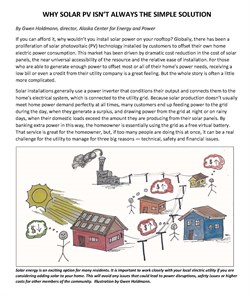Why Solar PV Isn’t Always The Simple Solution
Home-based solar photovoltaic systems can be viable in Alaska, but they create challenges if not installed in close coordination with the local utility. Alaskans should understand not only the benefits of solar PV but also the potential effects on other residents and the utility grid that serves them, according to Gwen Holdmann, ACEP director. Holdmann described these challenges in a recent column.
Individual homes with solar PV systems that feed into and draw from the electric grid can raise technical issues and impact utility business models. Some of these issues are more significant in rural Alaska villages because grids are relatively small, Holdmann explained.
For example, small utilities whose customers have a lot of residential solar installations might need to run their generators at lower, inefficient levels and keep enough generation online at all times to account for times when solar output drops. Utilities also need to insure that power flowing over their three-phase lines remains balanced. Unorganized residential solar power installations, which use only one phase, can disrupt that balance and cause outages.
These challenges can be met, but often at a cost, Holdmann noted. Community-level solar projects organized in partnership with the utility and benefitting from economies of scale can reduce some of those costs while improving overall energy security and resilience, she said.
Solar energy is an exciting option for many residents. It is important to work closely with your local electric utility if you are considering adding solar to your home. This will avoid any issues that could lead to power disruptions, safety issues or higher costs for other members of the community. Illustration by Gwen Holdmann.




